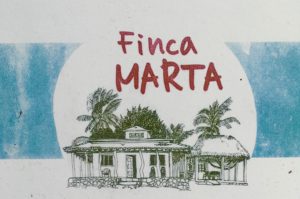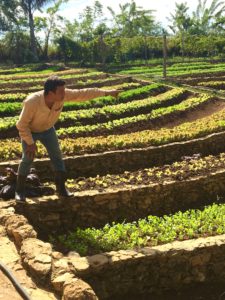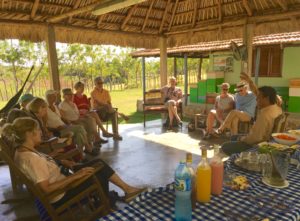Cuba’s Finca Marta: A Model Organic Farm:
Part I

West of Havana, 45-minutes’ drive, past the billboard announcing the province of Artemisa, an unmarked dirt road leads to Finca Marta, an impressive model of organic practices, integrated systems and respectful human relationships.
But please, do not get too excited that this is the future of Cuba agriculture. Despite the impression given by several documentaries and permaculture enthusiasts, organic farming in Cuba is very limited, uncommon and its produce not available to the general population.
I will let Fernando R. Funes Monzote, Ph.D. agroecologist explain, as he did to a group of a dozen of us one recent and glorious afternoon spent at the paradisical Finca Marta.

This is Fernando and Finca Marta is his brainchild and labor of love. His father was a scientist and his mother, Marta – for whom the Finca (farm) is named – was a biologist. Fernando and Marta worked together for 15 years, and between 1996 and 2000 they visited 93 farms and documented the work of the Cuban organic farming organization to help develop in Cuba sustainable systems in what was – and largely still is – a monoculture model for industrial production: deforestation, sugar cane, coffee and tobacco.
But before that and after, Fernando spent years abroad; a rather unique situation for any Cuban. How did Fernando leave Cuba and learn from farmers around the world? As president of the student’s league at the University of Havana, he was invited to Italy in 1984-1992 and visited more than 20 countries. In 1996 he received a master in science in agrocology in Spain and returned to Cuba. After repeatedly being denied permission to go to the Netherlands, despite valid invitations, Fernando finally was able to leave Cuba again in 2000 and spent much of the next decade traveling and collaborating with agronomist colleagues in Europe, Africa and Latin America, while earning his Ph.D in 2008.
In 2011, he started Finca Marta, 8 hectres (16 acres) of land owned by a 97-year-old-man who granted Funes-Monzote the right to farm. (Remarkably, given their limited diet and the stresses of daily life in sourcing basic goods, Cuban’s lifespans are among the longest in the world, but that’s another story). But these rights are, like most things in Cuba, complicado, and Fernando may have to fight for succession and user rights. He hopes they will be granted, given all the work he and his workers have done to create this innovative operation. But he knows nothing in Cuba is certain.
Some history of Agriculture in Cuba

Fernando explained that from the end of the19th century (when the U.S. helped Cuba win independence from Spain and was then able to claim commercial rights) until the revolution in 1959, U.S. companies used pesticides, herbicides and chemical fertilizers. Part of the reason for the revolution was “agrarian reform.” Lots of money was in the hands of a few and the issues of inequity were obvious – social, economic, environmental, and oppressed rural populations. The revolution promised reorganization and redistribution of lands into the hands of the farmers.
After 1963, and the U.S. embargo, Cuba had to look for new allies and reorient to Eastern European imports and exports. The 80/20 population distribution flipped from rural to urban. Cuba became a laboratory for modern Soviet-funded technologies, built on productivity and competition.
This was embodied in “Fidel’s Cow” recorded in the Guinness World Book of Records as producing 27,000 liters of milk in its productive life, up to 11 liters in one day. This was evidence of Cuban prowess. There were also developments of new water systems – lakes, ponds and reservoirs, and scientists assigned to these projects. But, the industrial agricultural production of the 1970s and 80s came to an abrupt and devastating halt after the fall of Cuba’s main trading partner.
Everything fell apart. Tractors, trucks and other machinery without parts and fuel for operation and distribution of goods rusted in the fields, no more fertilizers and pesticides meant common crops no long grew or were harvested. Oxen were used as in centuries past and a dystopian period descended on the island.
Although Fernando did not go into detail, if you’ve not read about what Fidel Castro optimistically called “the Special Period in the time of peace,” I suggest you do so. Because the U.S. had no ostensible relationship with Cuba, the fact that the average Cuban lost 20% of their weight in a prolonged period of austerity, scarcity and fear – from which, questionably, it has never recovered – did not register in American media nor most of its allies.
To be Continued in Part II
